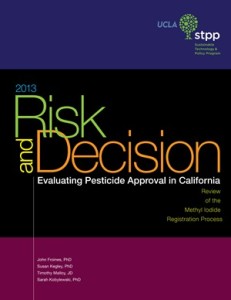Pesticide Registration: Time for an Upgrade
UCLA Study Offers Recommendations to Improve the Pesticide Approval Process in California
 We love our fresh fruits, vegetables and nuts in California. They are healthy for us and for our economy; California leads the nation with agricultural revenues of over 44 billion dollars annually, and produces nearly half of the fruits, nuts and vegetables grown in the U.S. But modern agriculture relies heavily on fumigants to produce this bounty in California and elsewhere in the United States. Fumigants are a form of pesticide typically applied to the soil before crops are planted. They essentially sterilize the soil, killing the worms and pests so the strawberries, tomatoes and other high value crops can survive. Fumigants are by definition poisons, so California law requires regulatory approval of new fumigants in a process called registration. The problem is that it hasn’t worked so well of late in California. A new report by UCLA’s Sustainable Technology & Policy Program (STPP) identifies a variety of deficits in the registration process and makes recommendations to improve pesticide regulation in California.
We love our fresh fruits, vegetables and nuts in California. They are healthy for us and for our economy; California leads the nation with agricultural revenues of over 44 billion dollars annually, and produces nearly half of the fruits, nuts and vegetables grown in the U.S. But modern agriculture relies heavily on fumigants to produce this bounty in California and elsewhere in the United States. Fumigants are a form of pesticide typically applied to the soil before crops are planted. They essentially sterilize the soil, killing the worms and pests so the strawberries, tomatoes and other high value crops can survive. Fumigants are by definition poisons, so California law requires regulatory approval of new fumigants in a process called registration. The problem is that it hasn’t worked so well of late in California. A new report by UCLA’s Sustainable Technology & Policy Program (STPP) identifies a variety of deficits in the registration process and makes recommendations to improve pesticide regulation in California.
The report, “Risk and Decision: Evaluating Pesticide Approval in California,” uses one fumigant—methyl iodide or MeI—and the story of its registration for use on strawberries as a case study. MeI (used in combination with another fumigant chloropicrin) was introduced as a substitute for methyl bromide, a widely used fumigant slated for phase out by 2015 due to its ozone-depleting nature. While the methyl iodide/chloropicrin mixture was a promising alternative in terms of performance, it raised substantial human health issues, including neurotoxicity, carcinogenicity, and developmental toxicity. The high volatility and high application rates used for soil fumigation guarantee significant exposure for workers and those living and working near a fumigation site. Yet the California Department of Pesticide Regulation (DPR) approved its use in December 2010 despite opposition from a wide range of scientists, environmental, and farm worker groups.
The report examined the risk governance approach used during methyl iodide’s approval, comparing it to best practices in regulatory settings, including risk assessment practices as developed by the National Research Council. We drew upon letters, hearing transcripts, reports, internal DPR memos, and other documents and analyzed the scientific, social and legal dimensions of pesticide registration in California on the ground. Our evaluation identified a number a substantial deficits in the registration process, including:
- considering only the risks of methyl iodide, rather than focusing on cumulative exposure to the methyl iodide/chloropicrin mixture that would be used in practice;
- Refusing to evaluate safer chemical and non-chemical alternatives to the fumigant as required by law; and
- Revising the scientific conclusions of the risk assessment regarding acceptable exposure levels under circumstances that suggest that the revised levels were selected so as to support economically acceptable mitigation measures.
The report concludes with a set of recommendations for reform focused upon four principles:
- Realistic Framing and Assessment of Risk
- Use of Best Available Science/Data and Exercise of Caution
- Embracing Prevention of Risk
- Engaging in Transparent, Interactive Decision-Making
The manufacturer voluntarily withdrew methyl iodide products from the U.S. market in March 2012 citing economic conditions. However, DPR never revised its conclusions, and the deficiencies in the approval process apparently remain.
The report can be found here.
Reader Comments
One Reply to “Pesticide Registration: Time for an Upgrade”
Comments are closed.







How did anybody find any “Revising the scientific conclusions of the risk assessment”? Aren’t drafts secret?